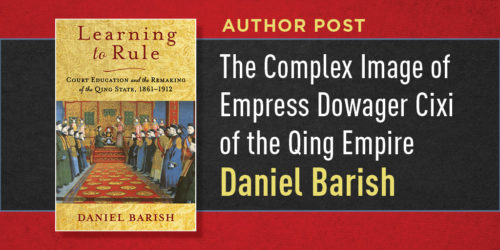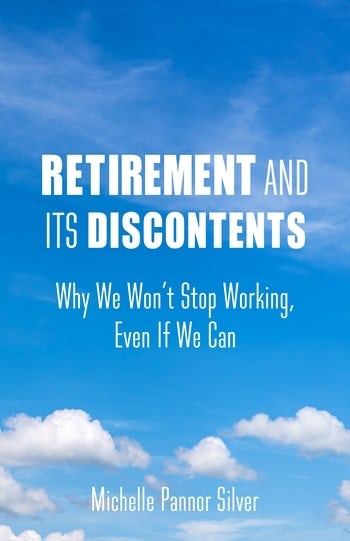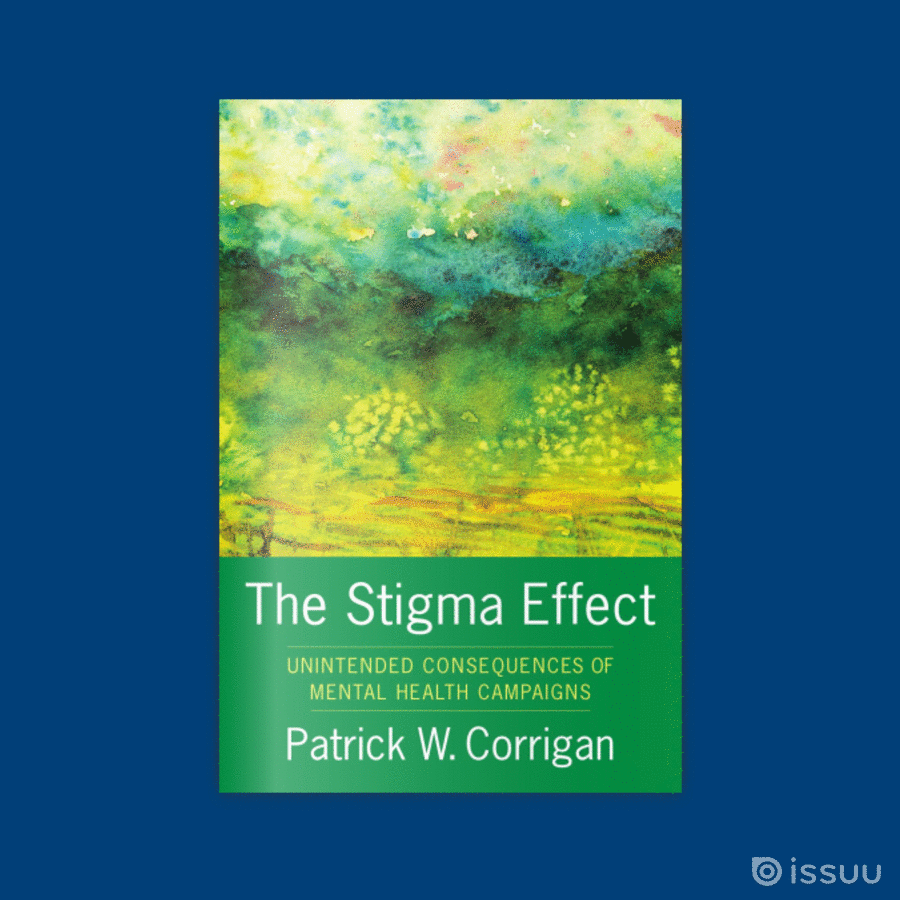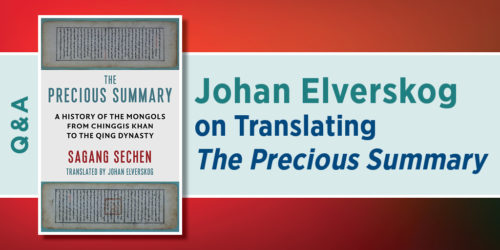Q&A with Max Oidtmann on Forging the Golden Urn

AQing law mandated that the reincarnations of prominent Tibetan Buddhist monks be identified by drawing lots from a golden urn. In Forging the Golden Urn, Max Oidtmann traces how a Chinese bureaucratic technology was exported to the Tibetan and Mongolian regions of the Qing empire and transformed into a ritual for authenticating reincarnations.
• • • • • •
Q: What is the “golden urn” in your book’s title and what is its significance in Tibet’s history?
Max Oidtmann: The “Golden Urn” was a small gold-plated copper pot forged in the Qing imperial palace workshops at the request of the Qianlong emperor (1711-1799) in the summer of 1792. Although the urn imitated the shape and decoration of a particular type of Tibetan ritual vessel, it was intended for use in a new ritual that had no precedent in Tibetan Buddhist traditions. The emperor instructed the elite monks and lamas of Tibet and Mongolia that henceforth they would identify the reincarnations of important lamas by putting the names of candidates (or “suspected incarnations”) on lots in the Golden Urn and then drawing one out. The winner of this lottery would be the “real and authentic incarnation,” and receive imperial sanction. The emperor himself subsequently admitted that the idea for what has been called the “Golden Urn Lottery” lay in a Chinese administrative tradition: the practice of appointing officials to various provincial magistracies by having them draw lots from a selection of open posts.
The Golden Urn was also a short-hand for a whole set of new regulations that attempted to dictate how Tibetan Buddhists should locate and identify reincarnations—the Golden Urn lottery was just the final stage of a complicated process. Qing officials also hoped that the Golden Urn would supplant Tibetan Buddhists’ reliance on a range of divination practices, most importantly the famous oracles of central Tibet. At its inception, the whole package was enormously controversial, not only in Tibet and Mongolia, but even among the emperor’s closest confidents and advisors. But within a decade, the Golden Urn became a fairly routine part of the process of identifying important reincarnations. And there were actually two urns, one in Beijing and one in Lhasa, the former for the identification of Mongol reincarnations and the latter for the identification of reincarnations hailing from Tibet, Amdo, and Kham. So, the fascinating question is, how did the Qing emperor and his agents pull this off? And why?
These two questions drive the narrative of my book. I recount the Qing court’s internal discussions about why it needed to get involved in the politics of reincarnation among Tibetan Buddhists (Part One); trace the campaign to persuade people in Mongolia and Tibet that the new laws were necessary and just (Part Two); and finally the strategies by which Tibetan elites themselves legitimized the lottery and incorporated it into their own traditions, transforming it from a “lottery” into a ritual—a divination technology—that revealed authentic rebirths (Part Three).
The Golden Urn was—and is—significant for several reasons. First, the new laws really did change the way that Tibetan Buddhists looked for reincarnations of a certain set of famous monks, at least until the Qing collapsed in 1911. It represented the first successful attempt by any authority, either the leaders of the Geluk school of Tibetan Buddhism or lay rulers, to come up with a unified and standardized process for locating reincarnations. It gave Qing authorities a clearer view of just what kinds of people were being identified as reincarnations and the ability to vet them somewhat. More interestingly, however, and perhaps unintentionally, it also contributed to the centralization of religious authority in the Tibetan government in Lhasa. From the outset, the emperor and Qing officials had envisioned Geluk elites in Lhasa as playing key roles in the new Golden Urn search process. And the new laws also led to the further expansion of the Lhasa government’s authority in the borderland, intermediary areas between China and Tibet such as Amdo and Kham. Few reincarnation lineages in Amdo and Kham had regularly had their rebirths confirmed by authorities in Lhasa prior to 1792.
In the 1990s the Chinese Communist Party resurrected the Golden Urn as a symbol of Chinese sovereignty in Tibet and as a tool to retain control over the physical personages of future Panchen Lamas and Dalai Lamas. Although the urn was interpreted by some Qing officials and Geluk prelates in the 19th century as an emblem of “Chinese” sovereignty, it is important to point out that “Chinese” sovereignty carried different connotations during that era.
The Qianlong emperor introduced the urn because he wished to impose his imperial domination over the arts of divination and prognostication of Inner Asia and shore up the unity of the Geluk school, not because he wished to suppress Tibetan or Mongol nationalism. When his officials and Tibetan elites spoke of Chinese control, they meant the sovereignty of the Chinese state, embodied in the personages of Qing rulers, not the “Chinese people.” Despite the deepening ties among the “people of China” fostered by inclusion in the Qing empire, the notion that there was some pan-imperial and sovereign “Chinese people” that transcended Tibetan, Han, Manchu, and Mongol would have to wait the work of late 19th-century Chinese nationalists.
Q: What are some of the larger questions that have driven your research about the history of law and religion in East and Inner Asia and how do they relate to this book project?
Oidtmann: My research has been animated by several questions such as: How did the Qing state retain control over its vast territories in Inner Asia (Tibet, Mongolia, Xinjiang, and Qinghai)? What role did the Qing colonial context play in shaping or influencing some of the major social and intellectual changes that unfolded in Tibet during the 19th-century (such as the accelerated growth of mass monasticism or the spread of “Tibetan” law and jurisprudence in areas like Amdo and Kham)? And what can we learn about Chinese history by comparing it to the historical experiences of neighboring empires such as those of the British or Russians?
For several generations historians of China have talked about how the Qing state patronized Tibetan Buddhism to gain supporters in Inner Asia, but there are few studies about how this worked in practice, outside of the rarified context of the Qing imperial palaces and sponsored monasteries. What did Qing officials themselves think about Buddhism and how did they interact with their Tibetan and Mongol interlocutors? What did Tibetans make of the Qing rulers and their agents? The story of the Golden Urn really allows us to explore all of these questions.
Q: What was the relationship like between the Qing state and the Geluk School of Tibetan Buddhism? How did the introduction of the golden urn ceremony impact that relationship?
Oidtmann: In their public pronouncements, both Qing rulers and Geluk hierarchs repeatedly celebrated their shared interest in promoting the Geluk teachings. To use some albeit anachronistic language, the relationship was “win-win.” Even before the Manchus and their allies entered the passes and conquered China in 1644, they had seen the utility of establishing close relations with Tibetan Buddhist authorities from a variety of different traditions (Geluk, Kagyu, Sakya, etc.). And it wasn’t useful merely for the political and military support this seemed to earn them among the Mongols. The relationship wasn’t simply transactional. Throughout the dynasty Qing rulers and many of their officials oriented their moral compasses and grounded their cosmologies on Tibetan Buddhism. And Tibetan Buddhist monks offered powerful spiritual and magical weapons to support the Qing state. In turn, Qing rulers provided financial support and a kind of autonomous administrative “space” in which the Geluk church in particular flourished—the number of monks and the size and wealth of their monasteries increased throughout the dynasty.
This is not to say, however, that the Qing state left the Geluk church untouched. My book reveals that although the Qianlong emperor was an adherent of the Geluk teachings, he did not think of himself as practicing Buddhist governance and was in fact quite antagonistic towards temporal governance by Geluk monks (as were many of his officials). Qing rulers repeatedly intervened in the politics of the Geluk church. The Qing state fundamentally reshaped important aspects of the Tibetan government—the so-called Ganden Podrang administration of the Dalai Lamas and their regents—in the mid 1700s and saw to it that this political order endured until the early twentieth century. When the Thirteenth Dalai Lama forcefully took the reigns of a newly independent Tibet from the smoldering ashes of the Qing empire in 1912, some credit for the fact that he still had a unified state to lead belonged to Qing authorities.
With regards to the Golden Urn ritual, many Tibetan elites saw the urn and the set of new regulations it embodied as a continuation of past practices. What is striking (and sometimes frustrating from the perspective of a historian) is that Tibetan chroniclers didn’t really comment a lot about the urn. Until the late 1800s, I have found no public attempt by any major Geluk authority to delegitimize the Golden Urn. I think this is because it was used in a limited fashion as part of a greater set of procedures, many of which were quite familiar, and because influential Geluk monks justified its use early on. These monks shared with the Qing ruler a common interest in identifying authentic rebirths and, perhaps more importantly, making sure that the identification process was credible to their followers. On several occasions, Geluk authorities successfully persuaded the Qing court that the urn should not be used, but these efforts should not be interpreted as a rejection of either the legitimacy of the urn ritual or of Qing rule.
Q: Why was the golden urn ceremony resurrected by the Chinese government in 1995? How was its resurrection received in Tibet?
Oidtmann: I think that the decision to revive the ritual in 1995 in the midst of the search for the reincarnation of the 10th Panchen Lama was hastily made and ill-conceived. It was a panicked response of a narrow group of cadres who were desperate to regain control of a process that had slipped out of their control. The CCP was not confident about its ability to control Tibet, China was isolated internationally, and the Dalai Lama had preemptively identified a child as the reincarnation of the Panchen Lama and had numerous persuasive justifications for his choice. Among Tibetans inside and outside Tibet, the Golden Urn is regarded with derision and the legitimacy of the children selected by the urn is highly suspect. The PRC has made enormous efforts to legitimize the urn through claims of historical continuity and respect for tradition, but these arguments have been fatally undermined by the obvious cynicism of their sudden decision to resurrect the ritual in the context of the 1995 crisis. Much like the Qing rulers, the CCP believes that sovereignty hinges on the domination of religion. But unlike the Qing, they have expressed this domination in a nationalistic language utterly foreign to Buddhism or other indigenous traditions. And few Tibetan elites, even those allied to the CCP, have been willing or given the space to translate the procedure into more palatable language.
Unfortunately, however, in the last decade the opinions of Tibetans have mattered less and less. As an economic and military superpower, the PRC—for the time being—does not need to make concessions to Tibetan sentiments. Moreover, the ritual has been performed increasingly (and with ever greater regularity) for a domestic Han audience. This audience has found the revival of Qing traditions far more alluring. The Golden Urn is now an emblem of China and the Chinese people’s historic great power status. It has therefore been much easier for the CCP to persuade the Han, the Party’s primary constituency, that its cadres have a legitimate role to play in the identification of lamas. The Han are the audience that really matters in the domestic politics of China. So long as they enjoy the spectacle—a Qing costume drama interjected with the romance and exoticism of reincarnation—the PRC will continue to use the urn to select reincarnations of eminent Tibetan lamas.
Q: How would you like Forging the Golden Urn to complicate or challenge our understanding of Qing and Tibetan history?
Oidtmann: Forging the Golden Urn is a revisionist history of Sino-Tibetan relations. As such, it challenges simplistic narratives that have been told by both Tibetan and Chinese nationalists. It may offend modern Chinese nationalist sensibilities by pointing out that Qing rulers did not see themselves as acting in the interests of the Chinese people, nor did they see themselves as “perfecting” or further consolidating centuries of “Chinese” sovereignty. Quite to the contrary, the Qianlong emperor and his agents thought the degree of control they had established (or hoped to establish) was entirely unprecedented. Moreover, their notions of sovereignty and the meaning of “China” were quite different from today. Historicizing concepts of sovereignty and faith—trying to figure out what these words meant in their 18th century context—was one of the key goals of my research.
The book may offend Tibetan nationalists as well because many historical documents, including those authored by Tibetans, reveal that Tibetan religious and lay elites were not axiomatically opposed to Qing rule or the implementation of the Golden Urn. It was not perceived as some sort of violation of Tibetan sovereignty or religious autonomy. In fact, one of the more fascinating discoveries in the archives were the efforts of numerous Geluk monks and lamas to support the Qianlong emperor’s policies and even provide theological rationales for the Golden Urn. The Tibetan elites, however, were not push-overs. They also prevented Qing officials from implementing key aspects of Qianlong’s instructions, most importantly the emperor’s wish that Tibetans abandon their use of oracles and other traditional divination technologies.
Hopefully this book’s primary contribution is to reveal the messiness of the Qing empire’s expansion into Mongolia and Tibet during the 18th and 19th centuries. The vast scale of modern China was not preordained. Like the growth of the British and Russian empires, Qing colonialism was fraught with anxiety and insecurity—it was a work-in-progress whose durability hinged on all kinds of contingent decisions and confusing encounters with people from different cultural backgrounds.








